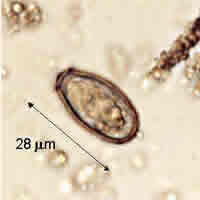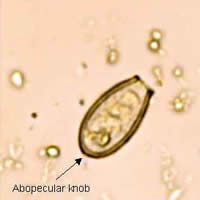Answer to
Case 23
This was a case of infection with Clonorchis sinensis, a liver fluke.
Metagonimus yokogawai and Opisthorchis species are also
acceptable answers since the eggs of these three species are virtually
indistinguishable and both are found in Asia (Korea). The diagnostic
features noted were size, obvious presence of an operculum, and the small
abopercular knob (indicated by the arrow in Figure B below).
The images are from a formalin fixed stool concentrate (400×).
These eggs are sometimes confused with those of intestinal flukes such as heterophyids and metagonamids, which also have small, operculate eggs. Usually, the eggs of intestinal flukes are smaller, ranging from 20 to 30 micrometers by 15 to 17 micrometers whereas eggs of the liver flukes are generally larger (27 to 5 micrometers by 12 to 9 micrometers) and have a more conspicuous, or seated, operculum and have a small knob at the abopercular end. Geographic location of where the infection was acquired is helpful in making an accurate diagnosis.
 |
 |
| A | B |